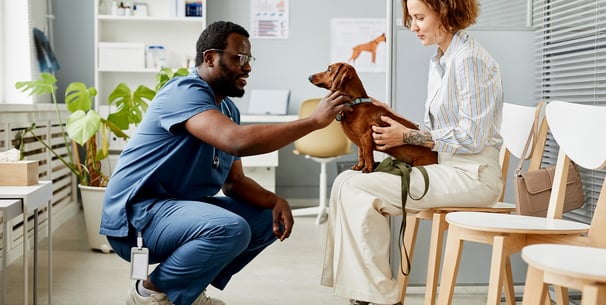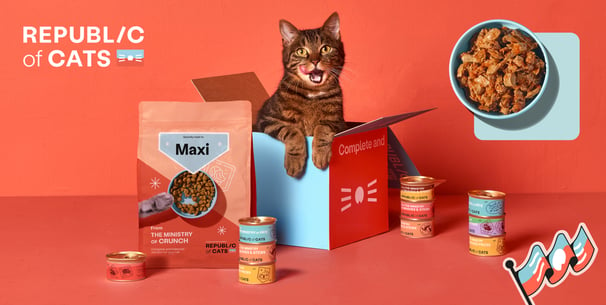The Purrfect Guide to Understanding Cat Eye Problems
Index:



Introduction
Eye health is incredibly important in cats. In their older age, cats can develop many of the same eye problems as us humans. Keeping your cat healthy and their immune system strong will help to reduce the chances of them developing any conditions as they age. However, sometimes these things happen.
To help you gain a better understanding of potential cat eye problems we’ve created this guide. Ready to begin?
What are common eye problems in cats?
Conjunctivitis
Conjunctivitis is the most common feline eye condition and is characterised by an inflammation of the thin mucous membrane that lines the inner part of a cat’s eyelid. This thin membrane also coats the outer surface of a cat’s eyeball. Because of how common this condition is, most cats contract it at some point in their lives.
The most common symptoms of viral conjunctivitis in cats include squinting, lots of blinking, swollen eyes, and discharge that can appear watery or dark and thick. Cats whose immune systems may be weaker, like those with feline immunodeficiency virus (FIV) or the feline leukaemia virus (FeLV) are more likely to contract it.
Corneal ulcers
The cornea is the transparent part of a cat’s eye that covers the iris and pupil. The cornea allows light to enter the eye but it can be damaged resulting in corneal ulcers. Feline corneal ulcers can be caused by a variety of things such as ingrown eyelashes, exposure to chemicals, dirt trapped under the eyelid, or bacterial infections.
The most common cause of corneal ulcers in cats is exposure to the feline herpes virus (FHV). Most cats who contract this virus are very young meaning throughout their life it can flare up and attack the eye surface leading to ulcers.
For some cats, corneal ulcers can suddenly disappear. However, this doesn't mean they’ve gone away and can, in fact, reappear at any time.
Glaucoma



Feline glaucoma is a painful condition where the watery fluid at the front of the eye is unable to drain correctly. This build-up of fluid puts pressure on the optic nerve which leads directly to the brain. This nerve damage often results in partial or full blindness. Once the condition occurs, it cannot be reversed.
There are two types of this eye disease. Primary glaucoma is an inherited breed-specific condition mainly affecting Siamese and Burmese cats. Cats with primary glaucoma in one eye are likely to develop it in the other eye.
Secondary glaucoma is considered a more random eye disease and can occur in one or two eyes unpredictably. The most common cause of secondary glaucoma is a severe eye inflammation called uveitis. Uveitis refers to built-up proteins and debris that block the drainage ducts in the eye. Uveitis can be caused by feline immunodeficiency virus (FIV), feline leukaemia virus (FeLV), toxoplasmosis, or feline infectious peritonitis (FIP).
Cataracts



Cataracts are a condition that affects the opacity of the lens in the eye. Over time it causes the eye to become cloudy, making it difficult for a cat to see as light cannot reach the retina. Depending on the severity of the issue, it can impact a cat's vision.
Though cataracts can affect any cat of any age or sex, some breeds are genetically predisposed to inherited cataracts such as Birmans, British Shorthairs, and Himalayans.
There isn’t just one cause of cataracts. In fact, any form of damage to the eye lens can cause cataracts to form. The most common causes include inflammation, hereditary factors, eye trauma, cancer, nutritional imbalances, diabetes, or any form of infection.
Eyelid abnormalities



Problems affecting a cat’s eyelid can be present at birth or may appear as a further result of injury or disease. The most common type of eyelid problem is called blepharitis. Any condition that causes irritation to the eyelids can lead to feline blepharitis.
Common causes of blepharitis include allergies, tumours, congenital abnormalities, viral infections and other inflammatory conditions. The most common eyelid abnormality that can lead to blepharitis is called entropion.
Entropion is a condition in which the edges of the eyelid turn inward and rub against the cornea. This can be very uncomfortable and cause additional disorders to develop. Cats with flatter faces and/or folds in their skin are prone to developing entropion, especially those with lagophthalmos, that’s the fancy word for bulging eyes.
Progressive retinal atrophy (retinal disease)



Progressive retinal atrophy (PRA) refers to a group of degenerative diseases that affect the photoreceptor cells in the eye. With any degenerative disease, over time, the cells deteriorate leading to blindness.
There are two different types of PRA, one is an inherited form called retinal dysplasia that is diagnosed in kittens around 2 to 3 months old and the other is a later onset form often detected in adult cats aged 2 to 5 years. Most vets refer to the late-onset form as PRA and the early-onset one as retinal dysplasia.
Retinal dysplasia occurs as a result of abnormally developed retinas which leads to blindness. Onset PRA is caused by deteriorating rod cells that cause night vision to be affected first, before daytime vision. After time, the cone cells in the eye that help daytime vision are affected leading to complete blindness.
What do unhealthy cat eyes look like?



If you’ve noticed a change in your cat’s eyes, it’s important to know what to do next. If your cat appears healthy, it’s still good to know what signs to look for if the worst-case scenario was to arise in the future.
Changes in a cat’s eyes can indicate illness through the body, not just in the eyes. The most common signs of an unwell cat include:
Drooping eyelids
Sensitivity to light
Yellow, green, or white discharge
Squinting
Visible clouded eyes
Dilated pupils
One pupil dilated more than the other (anisocoria)
Elevated third eyelid
You may be reading the last point and feel confused as to why cats have a third eyelid. Allow us to explain. In the corner of their eyes, cats have a nictitating (transparent) membrane, this is known as a third eyelid. It is usually retracted and not visible to us, however, when cats are sick it can become more noticeable.
If you’ve noticed any of the above signs in your cat, we recommend speaking to a vet. If you’re a Waggel member, you’ll be able to do so free of charge with Joii.
Joii is an online vet care app whereby you can book virtual consultations with registered vets across the UK. If you’ve noticed something unusual about your cat’s eye, using Joii can help you to gain peace of mind.
After your consultation, your vet will send over notes and advise you on further action to take e.g., visiting a vet in person for treatment.
When should I worry about my cat's eyes?
Cat eye problems can be very uncomfortable and even painful for cats. So if you’re a cat owner who has spotted an issue, don’t hesitate to seek veterinary help.
However, how do you know what’s serious and what will clear up with over-the-counter medication at home? As a general rule of thumb, if your cat displays any of the following signs, we recommend calling your vet or a veterinary ophthalmologist immediately:
A severely inflamed third eyelid
Red eyes
Excessive winking
Yellow, green, or clear discharge from the eye
Rubbing their eyes
Nasal discharge including blood (respiratory distress)
Another cause could be high blood pressure from hyperthyroidism or kidney disease which can lead to ruptures of the blood vessels in the retina.
It’s also important to take into consideration other factors such as age, breed, and underlying health conditions that can impact eye health.
Cat eye problems with discharge



Eye discharge is one of the most common tell-tale signs of an eye problem in cats. However, there’s not just one reason why cats struggle with discharge issues. Let’s take a look at the potential causes:
Feline respiratory infections
Feline respiratory infections are one of the most common causes of eye discharge and can be caused by a range of bacteria and viruses. Symptoms of feline respiratory disease often include a pus-like discharge that is sticky.
Epiphora
Epiphora is the name given to tearing, watery eyes. From blocked tear ducts to allergies and conjunctivitis, epiphora can cause a watery discharge and overproduction of tears. Conjunctivitis can also cause thick, mucus-like discharge.
Corneal issues
The cornea is the dome-shaped surface that protects the eye. However, it can become injured or inflamed (keratitis) resulting in corneal ulcers, watery discharge, and an overproduction of tears.
Dry eyes
Dry eye, also known medically as keratoconjunctivitis sicca, is caused by a lack of tear production. It can lead to a wide range of issues such as red, sore eyes and inflamed corneas. Without treatment, it can cause permanent blindness. Because the eye can’t produce watery tears, a gooey discharge can often be seen in the eyes.
Conclusion
So there we have it, our guide to understanding cat eye problems. There can be many causes of potential eye problems in cats, so try not to jump into immediate panic mode if your cat suddenly starts to show signs of an eye infection.
Some conditions are congenital whereas others are passed on from bacteria and can be treated with a course of antibiotics, eye drops, or antiviral medication.
The best thing to do is to consistently monitor your cat’s eye health and speak to your vet if you notice a development in symptoms related to potential eye issues. When it comes to eye health, it’s best to seek immediate help to avoid conditions escalating quickly.
If you’re a Waggel member, speak directly to a vet at a time that suits you best using online vet care provider, Joii. Simply download the app, sign up, and book a consultation.
As a pet owner, it’s important to be aware of any developing conditions in regard to your cat’s health. Regular eye exams and prompt treatment can significantly reduce the chances of your cat developing serious conditions in the future.
It’s also important to do your research before purchasing or adopting a cat. Becoming familiar with the breed of your choice, including any congenital issues, will help you understand more and know what to expect.
Want to read more about cat health? Visit our blog where we cover topics including what to do if your cat isn’t eating, how to treat feline ringworm, and our guide to cat pregnancy!
Waggel Pet Insurance
Need more help? You're in luck if you're a Waggel Pet Insurance member. Along with our excellent coverage, we offer access to a 24/7 online vet to answer all your sticky questions, especially if you need grooming assistance.
Not a member? Why not get a quote now and cover your furry friend for a range of illnesses, all while enjoying our amazing perks and rewards.
Want more like this?
Get updates from us with helpful info, advice, answers to frequently asked questions and much more.
Index:
Related posts:
Get your quote
Along with our excellent coverage, we offer access to a 24/7 online vet to answer all your sticky questions.





